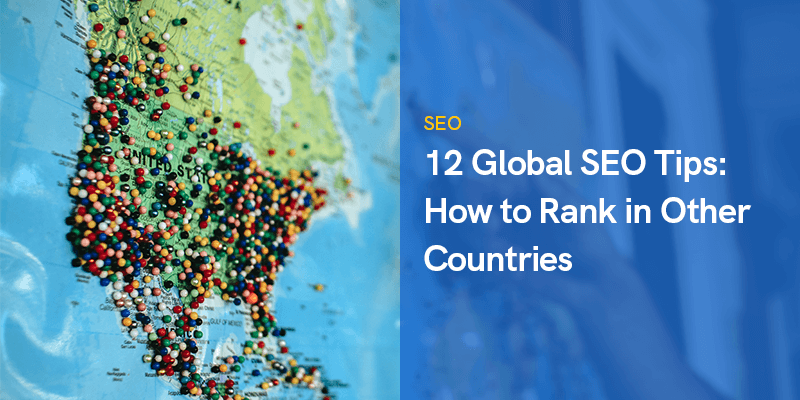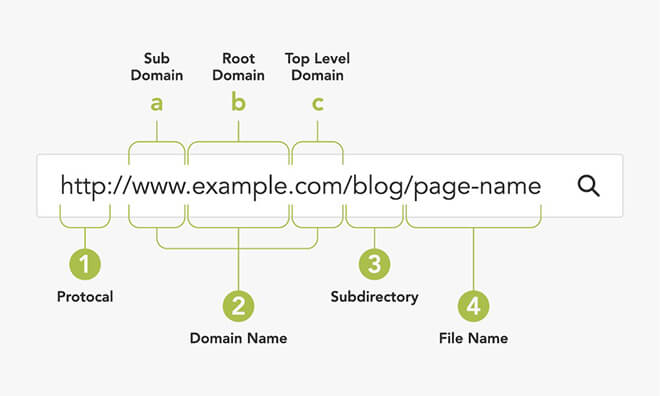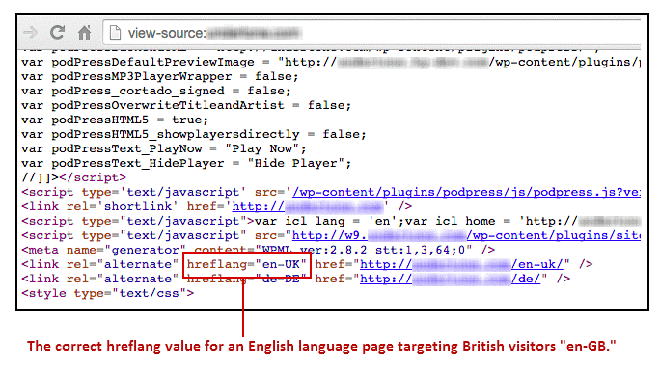
12 Global SEO Tips: How to Rank in Other Countries
In the next paragraphs you're going to learn about 12 global SEO tips & how to rank in other countries to improve your SERP rank globally.
How to Rank in Other Countries
There could be a number of reasons why you're focusing on improving your businesses visibility on the search engines.
Perhaps you’re trying to drive traffic to your blog, you want to build your brand or you're trying to drive more online sales.
Whatever your reasons, you're probably not just thinking about attracting visitors from your own country, it’s likely you’ll be thinking about your SEO on a global scale too.
That’s because advances in technology mean many companies are no longer restricted to just their local area or even nation.
It’s now possible to attract customers or readers from all over the world, opening businesses up to a much bigger pool of customers and/or users.
The result of which is that SEO is no longer just about ranking well in your own or even English-speaking countries.
In this guide, we’re going to look at global SEO and how you can get your website or blog ranking in other countries.
To do this, we’re going to look at:
- Whether targeting other countries is going to be costly
- How to decide which countries you should target first
- How to translate your content into other languages
- Whether it’s enough to simply translate your content
- Other ways you can optimize your website and content to rank in other countries
Is It Going to Cost Me Time and Money to Target Other Countries?
You may already be investing quite generously in your SEO efforts, so it’s understandable that you might be concerned about putting more into ranking globally.
But interestingly, it can actually be more affordable to invest in SEO for other countries.
This is because there is less competition for keywords so you’ll see better ROI and often in less time.
Of course, it will take up more of your time getting a strategy in place and working on your international SEO strategy, but your efforts will be worth it when you start to build more traffic and conversions from around the world.
How Do You Know What Countries to Target First?
You can begin narrowing down your target countries by looking at the most popular languages other than English.
Over 1.1 billion people across the world speak Mandarin Chinese, after that 544 million speak Hindi and 527 million speak Spanish.
This could give you an indication of which languages to target, but of course these languages are spoken in a number of countries, so you’ll still need to narrow it down further.
It’s important that you set goals for any SEO campaign whether it’s domestic or international.
And while trying to go after all of these popular languages would be great, it’s going to be far too time-consuming and costly.
What’s more, it could also mean you don't get the best results.
Instead, it’s a good idea to choose just one or two languages/countries to focus on.
So how do you choose which ones to start with? Data is going to be really important for this stage.
Using Google Analytics (or whichever tracking platforms you use for your site) you can see where most of your traffic comes from.
If you're getting large amounts of traffic from countries where English isn't the first language, for example, China or Brazil, take a look at if they are staying on your pages for long and if they're buying your products or services.
If they are, these should be your focus countries – so work out which languages are most popular in those regions.
Is Translating My Content the Key?
Now you know which countries/languages you're going to be targeting first – what’s next?
Initially translating your content into your chosen languages is going to be key.
But this doesn't mean simply translating your text into a different language and hoping it’ll rank well.
There are still other factors you need to take into consideration.
Once you’ve begun translating your content, you should also take the following three steps:
Keyword Research
Just because you know which keywords rank in English, this doesn't mean they’re going to rank the same in other languages.
So, in order to target the right keywords and rank well in other countries, you need to do some keyword research.
There are a number of tools you can use to find these keywords, it’s likely that you’ll have already invested in some of these tools for your existing SEO efforts.
When you know which relevant keywords are most popular in your chosen language you need to go beyond just translating old English content, you need to start editing your text to reflect this.
What’s more, you can also create fresh content with these keywords in mind.
Localising
It’s also important that you tailor your content to reflect the regions/countries you're going to be targeting.
For example, it’s no good having someone translate an existing blog post if it uses lots of English-specific phrases or makes reference to things that are only specific to one country.
At this stage, it might be helpful to hire translators or writers who have strong knowledge of the country and speak the local language.
They can help you to produce the best keyword-optimized content.
Link Building
Link building is an important part of SEO and the great news is this is much easier to do internationally than it is in English because SEO isn't as competitive.
Other countries aren't used to receiving cold outreach emails asking for them to share content etc.
As such, it’s much easier to secure links and get rankings.
Just be sure to avoid spam sites or paying for links.
How Else Can I Rank in Other Countries?
As well as translating your content, localising and link building as discussed above, there are some other steps you can take to help your content rank well in other countries.
Below are some other ways to boost your SEO efforts in your chosen countries.
Structure Your Site for Your International Audience
This can be a bit of a grey area, with some SEOs disagreeing on the best way to structure your site for an international audience.
But primarily, there are two ways you can do it, you just need to choose the one that’s right for your company.
You’ll have a choice between using subdomains or subfolders – but what exactly does this mean? Let’s look at a couple of examples below:
Subdomain: uk.website.com or de.website.com
Subfolder: website.com/uk or website.com/de
Choosing a subdomain is essentially creating a new domain altogether and can require separate hosting, some say this makes it harder and more costly to maintain, whereas subfolders exist on your initial domain as a separate landing page or part of the original site.
There has been an ongoing debate about which is the better option, but ultimately it’s down to your business, budget and how much time you have to maintain these.
If it were up to me I would usually opt for a subfolder, but one thing is for sure, you need to use either these subdomains or folders to help you structure your site for your international audience.

Hreflang Tagging
The good news about Google is that it doesn't penalize for duplicate content when it’s in a different language.
But this doesn't mean you can just translate the content and stick it up on your new landing pages.
The search engine needs to know which version to show visitors in each country and the way they know this is through hreflang tags.
These tags are page-level HTML tags and they can communicate to the search engine which specific country and language your content was created for.
The result of which is that your audience will be shown the more appropriate version of your content in their search engines results pages (SERPs).
This will hopefully lead to better results, lower bounce rates and higher conversion rates.
Hreflang can be confusing if you’ve not heard of it before, but the good news is there are a few options available that can help you to generate your hreflang code for your website.

Redirect Your Users
Just as Google Analytics shows you which countries your visitors have come from, this information is also being sent to your server.
So, after you’ve translated your content and added hreflang tags to your site, you’ll need to set up browser redirects for your audience.
The purpose of this is to automatically redirect visitors and to show them your content in their preferred language.
By not redirecting their browsers based on their location and preferred language, it takes search engines longer to rank your content for your chosen language/country instead of English.
This is also important for the user experience.
For example, imagine that someone visits your blog from Brazil and your browser is alerted that their preferred language is Portuguese, they can then be redirected automatically to the Portuguese version of your content.
Similarly, if someone visits from India, but their preferred language is English, you don't want to send them off to a Hindi version of the content just because they're in India.
Instead, that browser should recognize that the English content is preferred.
Not sure how to set up this type of redirect? Check out this guide for more information.
Consider Accelerated Mobile Pages (AMP)
Accelerated Mobile Pages (AMP) are pages that are optimized for mobile browsing with the aim of making your webpages load faster.
AMPs aren't such a big deal anymore for more competitive markets like the US where they have little effect on traffic, but in regions where infrastructure is still developing these can really help to boost traffic from mobile searches.
For example, in regions like Brazil or India, AMPs have been seen to boost traffic by as much as 32%.
If you choose not to use AMP that’s OK, but you need to make sure that you have optimized all your pages for the quickest possible loading speed times.
This can help to increase traffic and conversions.
If you're using WordPress for your website, make sure to checkout the link below about WP AMP Plugins: 5 Best WordPress AMP Plugins

Building a Community Around Your Content
Part of any good SEO strategy is building your brand and creating a community around your content, this is also true for your approach to international SEO.
By building your community your content becomes more trusted, shared and engaged with, which in turn, can help you to rank higher on SERPs.
And there are several key ways this can be done.
Social Media
Firstly, and perhaps most easily, you can use social media advertising to target your audience in specific countries.
For example, once you’ve translated your content or perhaps even created new adverts in your chosen language, platforms like Facebook and Instagram allow you to boost your posts in those regions and get them in front of a wider audience.
Commenting
If you speak any of these other languages, or if you’ve hired someone that does, it’s a good idea to reply to any comments from customers or readers on your website or blogs.
This can really help to boost your brand and build a community. If you haven't already, it might be worth hiring people who speak the native language.
This can be on a freelance or remote basis, but it pays to have someone who can respond thoughtfully and coherently to these comments.
Especially if you don't speak the language!
Events
For bigger companies, having someone on the ground in your chosen countries means they can spread brand awareness at local events and encourage people to engage with your content.
This, of course, will depend totally on the nature and size of your business.
In Summary
Becoming visible in search engines doesn't happen overnight no matter which countries you're targeting, but if you get an effective system in place you can really help to increase traffic and boost your rankings on a global scale.
Spend some time considering where your visitors/customers are coming to you from and this should help you to decide which countries you need to target first.
Translating your content into your chosen language is your first starting point, but it is by no means the end.
You also need to spend some time doing keyword research, localizing your content and link building.
The other key ways you can rank better in other countries include structuring your site for your international audience and adding hreflang tagging and browser redirects.
Finally, consider using Accelerated Mobile Pages (AMPs) and spend some time building up a community around your translated content.
Recommended Posts

Boost Event Visibility with MEC’s Top SEO Features in 2025
February 3, 2025

How to Earn Authority Backlinks for Your Website?
November 29, 2023
